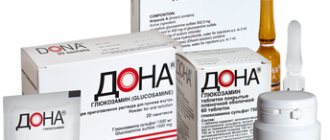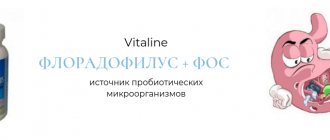Pharmacological properties of the drug Celebrex
The mechanism of action of celecoxib is the inhibition of prostaglandin synthesis, mainly through inhibition of COX-2. At therapeutic concentrations in humans, celecoxib does not have an inhibitory effect on COX-1. COX-2 is activated in response to the release of inflammatory mediators. Increased enzyme activity leads to the synthesis and accumulation of inflammatory prostanoids, primarily prostaglandin E2, which cause inflammation, swelling and pain. Celecoxib has anti-inflammatory, analgesic and antipyretic activity, blocking the production of inflammatory prostanoids by inhibiting COX-2. In animal studies, celecoxib reduced the incidence and number of colon tumors. In vivo and ex vivo studies have shown that celecoxib has very low affinity for constitutively expressed COX-1. Due to this, celecoxib in therapeutic doses does not affect the synthesis of prostanoids, which occurs upon activation of COX-1 and, accordingly, physiological COX-1-dependent processes in tissues, primarily in the stomach, intestines and platelets. Osteoarthritis and rheumatoid arthritis. Celecoxib can reduce joint pain, stiffness and swelling, and improve joint function in patients with osteoarthritis and rheumatoid arthritis. Celecoxib at a dose of 100 or 200 mg 2 times a day in patients with osteoarthritis significantly reduced the severity of pain within 24–48 hours after taking the first dose. The effectiveness of the drug at a dose of 200 mg/day did not depend on its use in one or two doses. Pain relief, including primary dysmenorrhea. Celebrex effectively reduced the severity of pain (from moderate to intense) after maxillofacial and orthopedic surgical interventions and in primary dysmenorrhea. A decrease in the severity of pain occurs within 1 hour after using the drug. Ankylosing spondylitis. When used at a dose of 100 mg 2 times a day, 200 mg 1 time a day and 400 mg 1 time a day, celecoxib significantly reduced the intensity of pain, the activity of the pathological process and improved functional ability in patients with ankylosing spondylitis when treated for 6-12 weeks . In general, the effectiveness of a daily dose of 200 or 400 mg was almost the same, however, a positive effect from a dose of 400 mg/day was noted in a larger number of patients. Familial adenomatous polyposis. When using celecoxib at a dose of 400 mg 2 times a day as an additional measure (in combination with endoscopic observation and surgical treatment), the number of polyps (in the duodenum and colon) and their size significantly decreased in patients with familial adenomatous polyposis. The use of celecoxib at a dose of 400 mg 2 times a day was effective and well tolerated. The number of side effects in patients with familial adenomatous polyposis was the same as in patients with arthritis. Endoscopic studies. There was no relationship between the incidence of gastroduodenal ulcers and the dose of celecoxib. The incidence of gastroduodenal ulcers and their complications (gastrointestinal bleeding, perforation or stenosis) in patients who used celecoxib was statistically lower compared to patients who used NSAIDs such as acetylsalicylic acid, naproxen, diclofenac or ibuprofen. Effect on platelet function. In healthy volunteers, celecoxib at therapeutic doses and at a dose of 600 mg 2 times a day (a dose that is three times the therapeutic dose) did not affect platelet aggregation and bleeding time. Effect on the cardiovascular system. The cardiovascular safety of celecoxib was studied in patients with sporadic adenomatous polyposis in the sporadic colorectal adenoma (SCA) and sporadic colorectal adenomatous polyposis (SCAP) prevention trials. The SCA Prevention Study, which lasted more than 3 years, found that celecoxib dose-dependently increased the risk of cardiovascular death, myocardial infarction, or stroke compared with placebo. There were no statistically significant differences in these indicators in the SCAP Prevention Study. When comparing the incidence of cardiac complications in the group of patients using celecoxib and in the group of patients using other non-selective NSAIDs, it was found that with long-term use of celecoxib, the incidence of non-fatal myocardial infarction tended to increase, the overall rates of cardiac mortality were similar, and the incidence cases of non-fatal stroke was significantly lower compared to similar indicators with the use of other non-selective NSAIDs. When compared with both placebo and other NSAIDs, simultaneous administration of acetylsalicylic acid did not affect these indicators. Pharmacokinetics. Absorption. Celecoxib is well absorbed when taken on an empty stomach; its concentration in the blood plasma reaches its maximum level after approximately 2–3 hours. Bioavailability when taken orally in capsule form is 99% compared to the bioavailability of the suspension (the optimal form for oral administration). When taken on an empty stomach, the maximum plasma concentration (Cmax) and AUC value are proportional to the dose when used in doses up to 200 mg 2 times a day; when using the drug in high doses, the increase in these indicators is less than proportional. Distribution. Plasma protein binding is independent of concentration and is about 97% at therapeutic concentrations. In the blood, the drug practically does not bind to red blood cells. Food addiction. Eating (especially high-fat meals) delays the absorption of celecoxib, prolongs the time to maximum concentration by approximately 4 hours, and increases bioavailability by approximately 20%. Metabolism. Celecoxib is metabolized primarily by cytochrome P450 2C9. Its three metabolites, which are contained in human plasma (primary alcohol, carboxylic acid derivative, glucuronide conjugate) are inactive regarding the inhibition of COX-1 and COX-2. The activity of cytochrome P450 2C9 is reduced in individuals with genetic polymorphisms that lead to a decrease in the activity of this enzyme, for example, homozygous polymorphism of the CYP 2C9 enzyme. The use of celecoxib in patients with known or expected reduced CYP 2C9 activity (based on previous experience with other CYP 2C9 substrates) should be used with caution (see APPLICATIONS). Application should be started with the lowest recommended dose. Selection. Excretion of celecoxib occurs primarily in the liver. In an unchanged state, less than 1% of the dose taken is excreted in the urine. With repeated use, the half-life is 8–12 hours, and clearance is about 500 ml/min. With repeated administration, the equilibrium concentration in the blood plasma is achieved within 5 days. Individual variability of pharmacokinetic parameters (AUC, maximum concentration, half-life) is about 30%. At steady state, the volume of distribution in healthy adults is approximately 500 L/70 kg, indicating a wide tissue distribution of celecoxib. Preclinical studies indicate that the drug penetrates the BBB. Special populations. Elderly patients. In patients over the age of 65 years, the average values of maximum concentration and AUC increase by 1.5–2 times. This effect depends mainly on body weight and not on the age of the patient. Celecoxib levels were higher in patients with lower body weights, so they may be elevated in older adults, who have a lower average body weight overall than younger adults. In elderly women, there is a tendency to higher concentrations of the drug in the blood plasma compared to men of the same age. No dose adjustment is usually required. However, elderly people with low body weight (less than 50 kg) are recommended to begin treatment with the drug in the minimum therapeutic dose. Race. The results of pharmacokinetic studies indicate that the AUC of celecoxib in blacks is approximately 40% greater than in Caucasians. The reason and clinical significance of this fact have not been established, therefore, it is recommended that people of the Negroid race begin treatment with a minimum therapeutic dose. Liver dysfunction. The concentration of celecoxib in patients with mild liver dysfunction (functional class A on the Child-Pugh scale) does not differ significantly from that in control group patients matched by age and gender. In patients with moderately severe liver dysfunction (functional class B on the Child-Pugh scale), the concentration of celecoxib in the blood plasma was approximately twice as high as in the control group. The usual daily dose of celecoxib in patients with moderate hepatic impairment should be reduced by approximately 50%. Renal dysfunction. In elderly volunteers with an age-related decrease in glomerular filtration rate (GFR) (mean GFR 65 ml/min/1.73 m2) and in patients with stable chronic renal failure (GFR 35–60 ml/min/1.73 m2) pharmacokinetics celecoxib was similar to that in patients with unchanged renal function. There was no significant relationship between serum creatinine levels (or creatinine clearance) and celecoxib clearance. The presence of severe renal failure should not affect the clearance of celecoxib, since the main route of its elimination is metabolism in the liver with the formation of inactive metabolites. Effects on the kidneys. At the present stage, the importance of COX-1 and COX-2 in kidney physiology has not been sufficiently studied. Celecoxib reduces the urinary excretion of PGE2 and 6-keto-PGE1α (a metabolite of prostacyclin) but does not affect serum levels of thromboxane B2 (THB2) or the urinary excretion of 11-dehydro-THB2 (a metabolite of thromboxane) (both compounds are products of COX- 1). The results of special studies showed that Celebrex does not cause a decrease in GFR in elderly people and patients with chronic renal failure. These studies also showed a transient partial decrease in sodium excretion. In patients with arthritis, the incidence of peripheral edema was similar to that observed with nonspecific COX inhibitors (which also exhibit COX-2 inhibitory activity). This effect was most pronounced in patients who received concomitant diuretic therapy. However, an increase in the number of cases of hypertension (arterial hypertension) and heart failure was not noted, and peripheral edema was mild and went away on its own. In standard preclinical studies studying chronic toxicity, mutagenicity and carcinogenicity, no particular risk to humans was identified. In relevant studies of toxic effects on the embryo or fetus, a dose-dependent incidence of diaphragmatic hernia in rats and impaired development of the cardiovascular system in rabbits were noted. In these studies, the AUC of the drug was more than 5-6 times higher than that when used at the maximum recommended dose (400 mg / day). In rats, when celecoxib was administered in the early period of embryogenesis, an effect on the embryo (its death before and after implantation) and a decrease in embryo/fetal survival were noted. This effect was detected when administered orally at doses approximately 6 times higher than those used in humans and can be explained by inhibition of prostaglandin synthesis.
Celebrex®
Celebrex®, given its antipyretic effect, can reduce the diagnostic significance of a symptom such as fever and affect the diagnosis of infection. Cardiovascular effects
Celecoxib, like all coxibs, may increase the risk of serious cardiovascular complications such as blood clots, myocardial infarction and stroke, which can be fatal. The risk of these reactions may increase with the dose, duration of use of the drug, as well as in patients with diseases of the cardiovascular system and risk factors for such diseases. To reduce the risk of these reactions in patients taking Celebrex®, it should be used in the lowest effective doses and for the shortest possible short course (at the discretion of the treating physician). The attending physician and patient should be aware of the possibility of such complications occurring even in the absence of previously known symptoms of impaired cardiovascular function. Patients should be informed of the signs and symptoms of adverse cardiovascular effects and measures to take if they occur.
When using NSAIDs (selective COX-2 inhibitors) in patients after coronary artery bypass surgery for the treatment of pain in the first 10-14 days, an increase in the incidence of myocardial infarction and cerebrovascular accidents is possible.
Due to the weak effect of celecoxib on platelet function, it cannot be a substitute for acetylsalicylic acid for the prevention of thromboembolism. Also, in this regard, antiplatelet therapy (for example, acetylsalicylic acid) should not be discontinued in patients at risk of developing thromboembolic complications.
Like all NSAIDs, celecoxib can lead to an increase in blood pressure, which can also cause complications from the cardiovascular system. All NSAIDs, including celecoxib, should be used with caution in patients with arterial hypertension. Monitoring of blood pressure should be carried out at the beginning of therapy with celecoxib, as well as during the course of treatment.
Effect on the gastrointestinal tract
Extremely rare cases of gastrointestinal perforation, ulceration, and bleeding have occurred in patients taking celecoxib. The risk of developing these complications during treatment with NSAIDs is highest in the elderly, patients with cardiovascular disease, patients concomitantly receiving acetylsalicylic acid, and patients with gastrointestinal diseases such as ulcers.
bleeding, inflammatory processes in the acute stage and in history. Other risk factors for the development of bleeding from the gastrointestinal tract are simultaneous use with oral glucocorticosteroids and anticoagulants, a long period of NSAID therapy, smoking, and alcohol consumption. Most spontaneous reports of serious gastrointestinal side effects were in elderly and debilitated patients.
Combined use with oral anticoagulants
When NSAIDs are used simultaneously with oral anticoagulants, the risk of bleeding increases. Caution is advised when using these drugs together. Oral anticoagulants include warfarin, coumarin anticoagulants, and direct oral anticoagulants (eg, apixaban, dabigatran, and rivaroxaban). Serious (some fatal) bleeding has been reported in patients receiving concomitant treatment with warfarin or similar agents. Since an increase in prothrombin time (international prothrombin time (IPT)) has been reported, anticoagulant activity and/or MH0 should be monitored in patients receiving concomitant therapy with oral anticoagulants after initiating treatment with Celebrex® or changing its dose. Fluid retention and swelling
As with other drugs that inhibit prostaglandin synthesis, some patients taking Celebrex® may experience fluid retention and edema, so caution should be exercised when using this drug in patients with conditions predisposing or worsened by fluid retention. Patients with a history of heart failure or hypertension should be closely monitored.
Effect on kidney function
NSAIDs, including celecoxib, may have toxic effects on renal function. Celecoxib was found to be no more toxic than other NSAIDs. Celebrex should be used with caution in patients with impaired renal function, heart failure, impaired liver function and in elderly patients. Renal function in such patients should be carefully monitored (see section "Dosage and Administration"). Caution should be exercised when using Celebrex® in patients with dehydration. In such cases, it is advisable to first rehydrate and then begin therapy with Celebrex®.
Effect on liver function
Celebrex® should not be used in patients with severe hepatic impairment (Child-Pugh class C). Celebrex® should be used with caution when treating patients with moderate hepatic impairment and the initial recommended dose of the drug should be reduced by half (see section "Dosage and Administration").
Severe liver reactions have occurred in some cases, including fulminant hepatitis (sometimes fatal), liver necrosis, and liver failure (sometimes fatal or requiring liver transplantation). Most of these reactions developed one month after starting celecoxib.
Patients with symptoms and/or signs of hepatic impairment, or those patients in whom laboratory tests have demonstrated hepatic impairment, should be closely monitored for the development of more severe hepatic reactions during treatment with Celebrex®.
Anaphylactic reactions
Cases of anaphylactic reactions have been reported while taking Celebrex® (see section "Contraindications").
Serious skin reactions
In extremely rare cases, serious skin reactions such as exfoliative dermatitis, Stevens-Johnson syndrome, and toxic epidermal necrolysis have been reported with celecoxib, some of which have been fatal. The risk of such reactions occurring is higher in patients at the beginning of therapy; in most reported cases, such reactions began in the first month of therapy. Stop taking Celebrex if you experience skin rash, changes in mucous membranes, or other signs of hypersensitivity.
Glucocorticosteroid therapy
Celebrex® cannot replace glucocorticosteroids or be used as therapy for glucocorticosteroid deficiency.
Inhibition of the function of the
CYP2D6
Celecoxib has been found to be a moderate inhibitor of the CYP2D6 isoenzyme. During the period of initiation of therapy with celecoxib, the dose of drugs metabolized by the CYP2D6 isoenzyme should be reduced, and after completion of treatment with celecoxib, the dose of these drugs should be increased (see section “Interaction with other drugs”).
Use of the drug Celebrex
Celebrex in a dose of up to 200 mg 2 times a day can be used regardless of meals. Since the risk of developing cardiac pathology when using Celebrex depends on the dose and duration of treatment, shorter courses of therapy and the minimum effective dose should be used if possible. Symptomatic treatment for osteoarthritis The recommended daily dose is 200 mg in one or two doses. The use of Celebrex in doses up to 400 mg 2 times a day was not accompanied by an increased risk of side effects. Symptomatic treatment for rheumatoid arthritis The recommended dose of Celebrex is 100–200 mg 2 times a day. The use of Celebrex in doses up to 400 mg 2 times a day was not accompanied by an increased risk of side effects. Ankylosing spondylitis The recommended dose of Celebrex is 200 mg once daily or 100 mg twice daily. In some patients, the effective daily dose is 400 mg. Relief of acute pain The recommended initial dose on the first day is 400 mg; if necessary, an additional 200 mg can be prescribed. In subsequent days, if necessary, the recommended dose is 200 mg 2 times a day. Primary dysmenorrhea The recommended initial dose on the first day is 400 mg; if necessary, an additional 200 mg can be prescribed. In the following days, if necessary, it is recommended to prescribe a dose of 200 mg 2 times a day. Familial adenomatous polyposis During treatment with Celebrex, it is necessary to continue standard therapy for polyposis. In order to reduce the number of colorectal polyps in patients with familial adenomatous polyposis, it is recommended to use the drug at a dose of 400 mg 2 times a day. This dose should be taken with food to improve absorption of the drug. Elderly patients Dose adjustment is usually not required, however, in elderly people weighing less than 50 kg, treatment should begin with the minimum recommended dose. Impaired liver function In patients with mild impairment of liver function (functional class A on the Child-Pugh scale), no dose adjustment is necessary. In patients with moderate hepatic impairment (Child-Pugh functional class B), treatment of patients with arthritis or acute pain should begin with the minimum recommended dose. The daily dose of Celebrex for use in patients with familial adenomatous polyposis with concomitant moderately severe liver dysfunction (functional class B on the Child-Pugh scale) should be reduced by 50%. There is no clinical experience with the use of the drug in patients with severe liver dysfunction (functional class C on the Child-Pugh scale). Impaired renal function In patients with mild to moderate renal failure, no dose adjustment is required. There is no clinical experience with the use of the drug in patients with severe renal failure. Patients with reduced metabolism of CYP 2C9 . Celecoxib should be used cautiously in patients with known or expected decreased CYP 2C9 activity, as evidenced by previous experience with other CYP 2C9 substrates. In such patients, half the minimum recommended dose should be used at the beginning of therapy.
Side effects of the drug Celebrex
In controlled clinical studies lasting up to 12 weeks, the following side effects were observed when celecoxib was administered at a dose of 100–800 mg with a frequency of more than 0.01% and more often than with placebo: Frequent (≥1% and ≤10%) Immune system: increased severity of allergy manifestations. Mental: insomnia. Nervous system: dizziness, muscle hypertonicity. Cardiovascular system: peripheral edema. Respiratory organs: bronchitis, cough, pharyngitis, rhinitis, sinusitis, upper respiratory tract infections. Digestive tract: abdominal pain, diarrhea, dyspepsia, flatulence, dental diseases. Skin: itching, rash. Kidneys and urinary tract: urinary tract infections. General manifestations: flu-like reactions. Injuries, poisonings and complications of procedures: accidental injuries. Uncommon (≥0.1 and ≤1%) Blood system: anemia, ecchymosis, thrombocytopenia. Mental: anxiety, drowsiness. Organ of vision: blurred vision. Vestibular apparatus and hearing organs: tinnitus. From the heart: hypertension (arterial hypertension), arrhythmia, palpitation, tachycardia. From the side of blood vessels: hot flashes. Digestive tract: vomiting. Skin and subcutaneous tissue: alopecia, urticaria. Isolated (0.01% and ≤0.1%) Immune system: angioedema. Mental: confusion. Cardiovascular system: chronic heart failure. Digestive tract: stomach and duodenal ulcers, esophageal ulcers, intestinal perforation, pancreatitis. Hepatobiliary system: increased activity of liver enzymes. Skin and subcutaneous tissue: bullous rash. Additional side effects were recorded during long-term (up to 3 years) prevention of polyps using the drug in doses of 400–800 mg/day. Very common (10%) From the cardiovascular system: hypertension (arterial hypertension). From the digestive tract: diarrhea Frequent (1% and ≤10%) Infections: ear infection, fungal infections (mainly non-systemic). From the cardiovascular system: angina pectoris, myocardial infarction. From the respiratory system, chest and mediastinum: dyspnea. From the vascular system: nausea, gastroesophageal reflux disease, diverticulum, vomiting, dysphagia, irritable bowel syndrome. Musculoskeletal and connective tissue disorders: muscle spasms. From the kidneys and urinary system: nephrolithiasis. From the reproductive system and mammary glands: benign prostatic hyperplasia, prostatitis. Analytical data: increased levels of creatinine in the blood, prostate-specific antigen, body weight. Uncommon (0.1% and ≤1%) Infections: Helicobacter pylori infection, herpes zoster, erysipelas, wound infections, gum infection, labyrinthitis, bacterial infection. Benign, malignant and neoplasms: lipoma. Mental: sleep disorder. From the nervous system: ischemic stroke. From the organs of vision: opacification of the vitreous body, hemorrhages in the conjunctiva. From the organs of hearing and balance: hypacusia. From the cardiovascular system: unstable angina, aortic valve insufficiency, atherosclerosis of the coronary arteries, sinus bradycardia, ventricular hypertrophy. From the vascular system: deep vein thrombosis, hematoma. From the respiratory system, chest and mediastinum: dysphonia. From the digestive tract: hemorrhoidal hemorrhage, increased intestinal motility, oral ulcers, stomatitis. From the skin and subcutaneous tissue: allergic dermatitis. From the musculoskeletal and connective tissue side: ganglion. From the kidneys and urinary system: nocturia. From the reproductive system and mammary glands: vaginal bleeding, breast tenderness, dysmenorrhea, ovarian cyst, menopausal symptoms. General manifestations and changes at the injection site: swelling. Analytical data: increased levels of potassium and sodium in the blood, decreased levels of testosterone in the blood, decreased hematocrit, increased hemoglobin. Injuries, poisoning and complications of the procedure: foot fracture, lower limb fractures, epicondylitis, tendon rupture, fractures. In the post-marketing period, the following side effects were noted: immune system - anaphylaxis; mental - hallucinations; nervous system - aseptic meningitis, ageusia, anosmia; vascular - vasculitis; digestive tract - gastrointestinal bleeding; hepatobiliary system - hepatitis, liver failure; kidneys and urinary system - acute renal failure, interstitial nephritis; skin and subcutaneous tissue - photosensitivity reactions, exfoliative dermatitis, erythema multiforme, Stevens-Johnson syndrome, toxic epidermal necrolysis; reproductive system and mammary glands - menstrual irregularities.
Contraindications:
- Hypersensitivity to celecoxib or any other component of the drug.
- Known hypersensitivity to sulfonamides.
- Complete or incomplete combination of bronchial asthma, recurrent polyposis of the nose and paranasal sinuses and intolerance to acetylsalicylic acid or other NSAIDs, including other COX-2 inhibitors (including a history).
- The period after coronary artery bypass surgery.
- Active erosive and ulcerative lesions of the mucous membrane of the stomach or duodenum, or peptic ulcer of the stomach and duodenum in the acute stage or gastrointestinal bleeding.
- Inflammatory bowel diseases.
- Chronic heart failure (II – IV stage according to NYHA).
- Clinically confirmed coronary heart disease, peripheral arterial disease and cerebrovascular disease in an advanced stage.
- Pregnancy and lactation (see section “Use during pregnancy and breastfeeding”).
- Severe liver failure (no experience with use).
- Severe renal failure (creatinine clearance less than 30 ml/min), progressive kidney disease, confirmed hyperkalemia (no experience with use).
- Lactase deficiency, lactose intolerance, glucose-galactose malabsorption.
- Age up to 18 years (no experience of use).
Special instructions for the use of Celebrex
influence on the cardiovascular system. Taking Celebrex increases the risk of serious cardiovascular thrombotic complications (myocardial infarction and stroke), which can be fatal. All NSAIDs can cause such complications, and the risk increases with increasing duration of treatment and in the presence of concomitant cardiac pathology. In order to minimize the potential risk of complications from the cardiovascular system when taking Celebrex, short courses of therapy and the minimum effective dose should be used whenever possible. Doctors and patients should be cautious about the possibility of developing such complications, even in the absence of cardiovascular disease. Patients should be informed about the signs and symptoms of serious cardiac complications and the necessary actions in this case. During coronary artery bypass surgery, in the first 10–14 days after surgery, the risk of myocardial infarction and stroke increases when taking selective COX-2 inhibitors. Celebrex is not an alternative to acetylsalicylic acid in the prevention of thromboembolism, as it does not affect platelet function. Since Celebrex does not inhibit platelet aggregation, antiplatelet therapy (including taking acetylsalicylic acid) should not be stopped when prescribed. Effect on the gastrointestinal tract. When using Celebrex, gastric and duodenal ulcers and their perforation, gastrointestinal bleeding may occur. The risk of developing such complications is higher in elderly patients, patients with diseases of the cardiovascular system, those using acetylsalicylic acid, patients with diseases of the digestive tract, including a history (peptic ulcer, gastrointestinal bleeding, inflammatory processes). Most often, fatal manifestations of the gastrointestinal tract were observed in elderly or debilitated patients. Hypertension. Celecoxib, like other NSAIDs, can lead to the onset of hypertension (arterial hypertension) for the first time or worsen the course of an existing one, which increases the risk of cardiovascular complications; the drug should be used with caution in patients with hypertension (arterial hypertension). Blood pressure should be carefully monitored at the beginning and throughout the course of celecoxib therapy. Fluid retention and swelling. As with other drugs that can inhibit prostaglandin synthesis, patients taking Celebrex may experience fluid retention and peripheral edema. Therefore, Celebrex should be used with caution in patients with heart failure or other conditions that may lead to or be worsened by fluid retention. Patients with heart failure or hypertension (arterial hypertension) should be monitored. Effect on the kidneys. Celecoxib, like other NSAIDs, can cause kidney toxicity. Patients with impaired renal function, cardiac damage, liver dysfunction, and elderly patients belong to an increased risk group for renal toxicity. Such patients should be under constant medical supervision during treatment with celecoxib. If you have kidney disease, kidney function should be monitored closely while taking celecoxib. Patients with dehydration require special caution. It is advisable to administer celecoxib only after rehydration. Effect on the liver. The use of the drug for the treatment of patients with severe liver damage (functional class C on the Child-Pugh scale) has not been studied. Therefore, the use of celecoxib in patients with severe liver damage is not recommended. Celecoxib should be used with caution in patients with moderate liver damage (Child-Pugh class B) and treatment should be started at the minimum recommended dose. In patients with symptoms of hepatic dysfunction, liver function tests should be regularly monitored to prevent deterioration of liver function. Anaphylactic reactions. In patients who have not previously had complications when taking Celebrex, anaphylactic reactions are possible. By reducing inflammation, celecoxib may reduce some symptoms, such as fever, which should be considered when diagnosing infections. Severe skin reactions. Very rarely, severe skin reactions have been reported with the use of Celebrex, including exfoliative dermatitis, Stevens-Johnson syndrome and toxic epidermal necrolysis. The highest risk of developing these reactions occurs during the initial stage of treatment. Most of these cases were noted during the first month of therapy. Celecoxib should be discontinued at the first manifestation of skin rash, changes in the mucous membranes, or other manifestations of hypersensitivity. Familial adenomatous polyposis. Treatment with celecoxib does not reduce the risk of developing gastrointestinal cancer and does not eliminate the need for prophylactic colectomy and other surgical treatments. Therefore, the usual treatment strategy in patients with familial adenomatous polyposis should not be changed due to the simultaneous use of celecoxib. In particular, the frequency of endoscopic examinations should not be reduced or the decision to perform colectomy or other surgical treatments should not be delayed. Children. Celebrex has not been studied in patients under 18 years of age. Use during pregnancy. There are no clinical data on the use of Celebrex in pregnant women. In animal studies, the drug had a toxic effect on the fetus. The significance of these data for humans is unknown. Celebrex, like other drugs that inhibit prostaglandin synthesis, can inhibit the contractile activity of the uterus and cause premature closure of the ductus arteriosus in the fetus, so use of the drug should be avoided in the third trimester of pregnancy. Celebrex can be used during pregnancy only in cases where the expected therapeutic effect for the mother outweighs the potential risk to the fetus. Use during breastfeeding. Studies in rats have shown that celecoxib passes into breast milk, where its concentrations are similar to those in plasma. Celecoxib is found in low concentrations in breast milk. Given the possible adverse effects in breastfed children, either breastfeeding or use of the drug should be discontinued, depending on the possible benefit to the mother.
Celebrex
Use during pregnancy and breastfeeding
There are insufficient data on the use of celecoxib in pregnant women.
The potential risk of using Celebrex during fluctuating periods has not been established but cannot be excluded. According to the mechanism of action, when using NSAIDs, including celecoxib, some women may develop changes in the ovaries, which can cause complications during pregnancy. In women who are planning pregnancy or undergoing evaluation for infertility, discontinuation of NSAIDs, including celecoxib, should be considered.
Celecoxib, which belongs to the group of prostaglandin synthesis inhibitors, when taken during pregnancy, especially in the third trimester, can cause weakness of uterine contractions and premature closure of the ductus arteriosus. The use of prostaglandin synthesis inhibitors in the early stages of pregnancy can negatively affect the course of pregnancy.
There is limited evidence that celecoxib is excreted in breast milk. Studies have shown that celecoxib is excreted into breast milk in very low concentrations. However, given the potential for side effects from celecoxib in a nursing infant, the advisability of stopping either breastfeeding or taking celecoxib should be assessed, given the importance of taking Celebrex® for the mother.
Use for liver dysfunction
In patients with mild hepatic impairment (class A according to the Child-Pugh classification), no dose adjustment is required. In case of moderate liver failure (class A according to the Child-Pugh classification), treatment should begin with the minimum recommended dose. There is no experience with the use of the drug in patients with severe liver failure (class C according to the Child-Pugh classification) (see section “Contraindications”).
Use for renal impairment
In patients with mild to moderate renal failure, no dose adjustment is required. There is no experience with the use of the drug in patients with severe renal failure (see sections “Special instructions”, “Contraindications”).
Use in children
Contraindicated in children under 18 years of age
special instructions
Celebrex, given its antipyretic effect, can reduce the diagnostic significance of a symptom such as fever and affect the diagnosis of infection.
Effect on the cardiovascular system
Celecoxib, like all coxibs, may increase the risk of serious cardiovascular events such as blood clots, myocardial infarction, and stroke, which can be fatal. The risk of these reactions may increase with the dose, duration of use of the drug, as well as in patients with diseases of the cardiovascular system and risk factors for such diseases. To reduce the risk of these reactions in patients taking Celebrex®, it should be used in the lowest effective doses and for the shortest possible periods (at the discretion of the attending physician). The attending physician and patient should be aware of the possibility of such complications occurring even in the absence of previously known symptoms of impaired cardiovascular function. Patients should be informed of the signs and symptoms of adverse cardiovascular effects and measures to take if they occur.
When using NSAIDs (selective COX-2 inhibitors) in patients after coronary artery bypass surgery for the treatment of pain in the first 10-14 days, an increase in the incidence of myocardial infarction and cerebrovascular accidents is possible.
Due to the weak effect of celecoxib on platelet function, it cannot be a substitute for acetylsalicylic acid for the prevention of thromboembolism. Also, in this regard, antiplatelet therapy (for example, acetylsalicylic acid) should not be discontinued in patients at risk of developing thromboembolic complications.
Like all NSAIDs, celecoxib can lead to an increase in blood pressure, which can also cause complications from the cardiovascular system. All NSAIDs, including celecoxib, should be used with caution in patients with arterial hypertension. Monitoring of blood pressure should be carried out at the beginning of therapy with celecoxib, as well as during the course of treatment.
Effect on the gastrointestinal tract
Extremely rare cases of perforation, ulceration and bleeding from the gastrointestinal tract have been observed in patients taking celecoxib. The risk of developing these complications during treatment with NSAIDs is highest in older people, patients with cardiovascular diseases, patients simultaneously receiving acetylsalicylic acid, and patients with diseases of the gastrointestinal tract such as ulcers, bleeding, inflammatory processes in the acute stage and in history. Other risk factors for the development of bleeding from the gastrointestinal tract are simultaneous use with oral corticosteroids and anticoagulants, a long period of NSAID therapy, smoking, and alcohol consumption. Most spontaneous reports of serious gastrointestinal side effects were in elderly and debilitated patients.
Combined use with warfarin and other anticoagulants
Serious (some fatal) bleeding has been reported in patients receiving concomitant treatment with warfarin or similar agents. Since an increase in prothrombin time has been reported, anticoagulant activity should be monitored after initiation of treatment with Celebrex® or a change in its dose.
Fluid retention and swelling
As with other drugs that inhibit prostaglandin synthesis, some patients taking Celebrex® may experience fluid retention and edema, so caution should be exercised when using this drug in patients with conditions predisposing or worsened by fluid retention. Patients with a history of heart failure or hypertension should be closely monitored.
Effect on kidney function
NSAIDs, including celecoxib, may have toxic effects on renal function. Celecoxib was found to be no more toxic than other NSAIDs. Celebrex® should be used with caution in patients with impaired renal function, heart failure, impaired liver function and in elderly patients. Renal function in such patients should be carefully monitored.
Caution should be exercised when using Celebrex® in patients with dehydration. In such cases, it is advisable to first rehydrate and then begin therapy with Celebrex®.
Effect on liver function
Celebrex® should not be used in patients with severe hepatic impairment (Child-Pyotr class C). Celebrex® should be used with caution in the treatment of patients with moderate hepatic impairment and should be prescribed at the lowest recommended dose.
In some cases, severe liver reactions have been observed, including fulminant hepatitis (sometimes fatal), liver necrosis, liver failure (sometimes fatal or the need for liver transplantation). Most of these reactions occurred 1 month after starting celecoxib.
Patients with symptoms and/or signs of hepatic impairment, or those patients in whom laboratory tests have demonstrated hepatic impairment, should be closely monitored for the development of more severe hepatic reactions during treatment with Celebrex®.
Anaphylactic reactions
Cases of anaphylactic reactions have been reported while taking Celebrex®.
Serious skin reactions
In extremely rare cases, serious skin reactions such as exfoliative dermatitis, Stevens-Johnson syndrome, and toxic epidermal necrolysis have been reported with celecoxib, some of which have been fatal. The risk of such reactions occurring is higher in patients at the beginning of therapy; in most reported cases, such reactions began in the first month of therapy. Stop taking Celebrex if you experience skin rash, changes in mucous membranes, or other signs of hypersensitivity.
Glucocorticosteroid therapy
Celebrex® cannot replace glucocorticosteroids or be used as therapy for glucocorticosteroid deficiency.
Impact on the ability to drive a car and operate machinery
The effect of celecoxib on the ability to drive a car and operate machinery has not been studied. However, based on the pharmacodynamic properties and overall safety profile, it appears unlikely that Celebrex® has such an effect.
Celebrex drug interactions
Metabolism of celecoxib occurs mainly in the liver under the influence of cytochrome P450 C YP 2C9. Assuming that the patient has low CYP 2C9 activity (as confirmed by previous experience with other CYP 2C9 substrates), Celebrex should be administered with caution, taking into account the possibility of a significant increase in plasma levels of the drug due to a decrease in its metabolic clearance. In vitro studies indicate that celecoxib is not a CYP2D6 substrate but an inhibitor. Therefore, there is the potential for in vivo of Celebrex with drugs that are metabolized by CYP 2D6. Interaction of celecoxib with warfarin and similar drugs. Cases of severe and even fatal bleeding may sometimes occur in patients receiving concomitant therapy with warfarin or similar drugs. Given that an increase in prothrombin time is observed when taking celecoxib, anticoagulation activity should be monitored after initiation of use or when changing the dose of celecoxib. Fluconazole and ketonazole. Co-administration of fluconazole at a dose of 200 mg 1 time per day leads to a 2-fold increase in the concentration of celecoxib in the blood plasma. This increase is noted due to the inhibition by fluconazole of the metabolism of celecoxib mediated by CYP P450 2C9. In patients receiving the CYP2C9 inhibitor fluconazole, treatment with Celebrex should be initiated at the minimum recommended dose. Ketonazole, a CYP3A4 inhibitor, does not affect the metabolism of celecoxib. Caution should be exercised when co-administering Celebrex with other CYP2C9 inhibitors. ACE inhibitors and angiotensin II antagonists. Prostaglandin synthesis inhibitors may reduce the antihypertensive effect of ACE inhibitors and/or angiotensin II antagonists when used concomitantly. However, clinical studies with lisinopril did not reveal significant pharmacodynamic interactions regarding the effect on blood pressure. Diuretics. Clinical studies have shown that in some patients, NSAIDs may reduce the natriuretic effect of furosemide or thiazides by inhibiting prostaglandin synthesis. Oral contraceptives. There was no significant effect of celecoxib on the pharmacokinetics of oral contraceptives. Lithium preparations. In healthy volunteers, plasma lithium concentrations increased by approximately 17% when combined with celecoxib. When concomitantly prescribing lithium with celecoxib, regular monitoring should be carried out. Acetylsalicylic acid. Celebrex does not affect the ability of acetylsalicylic acid in low doses to inhibit platelet aggregation. Given the lack of effect on platelet aggregation, Celebrex cannot be considered an alternative to acetylsalicylic acid in the prevention of complications of cardiovascular diseases. NSAIDs. Celecoxib should not be used concomitantly with NSAIDs. Other. No clinical interactions have been identified between celecoxib and the magnesium/aluminium-containing antacids omeprazole, methotrexate, glibenclamide (glyburide), phenytoin and tolbutamide.









